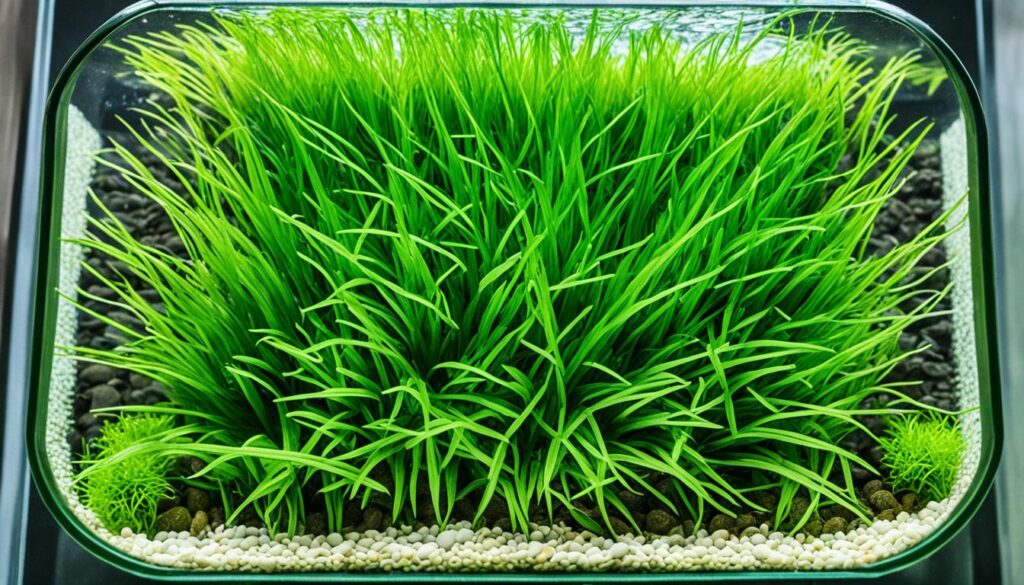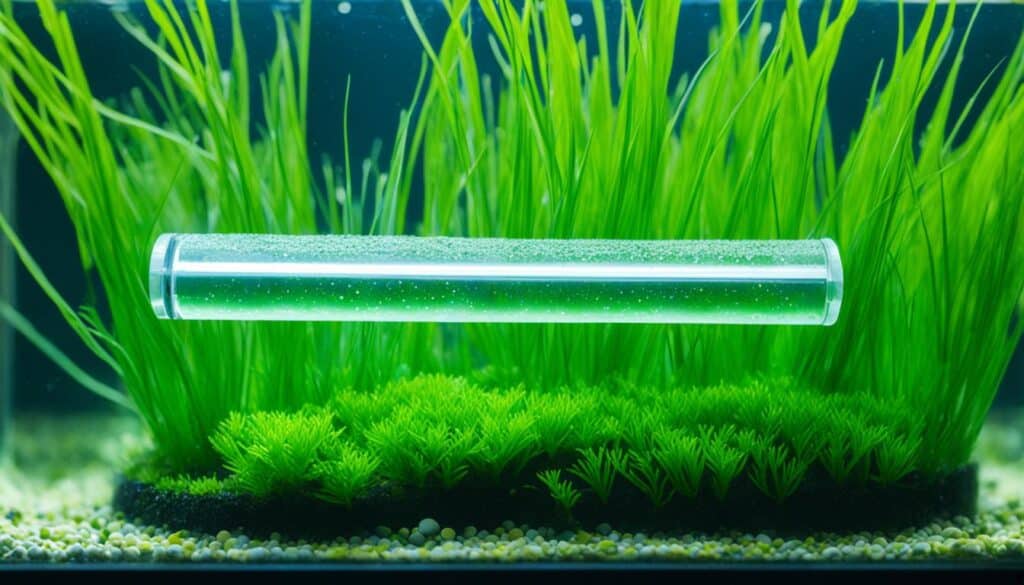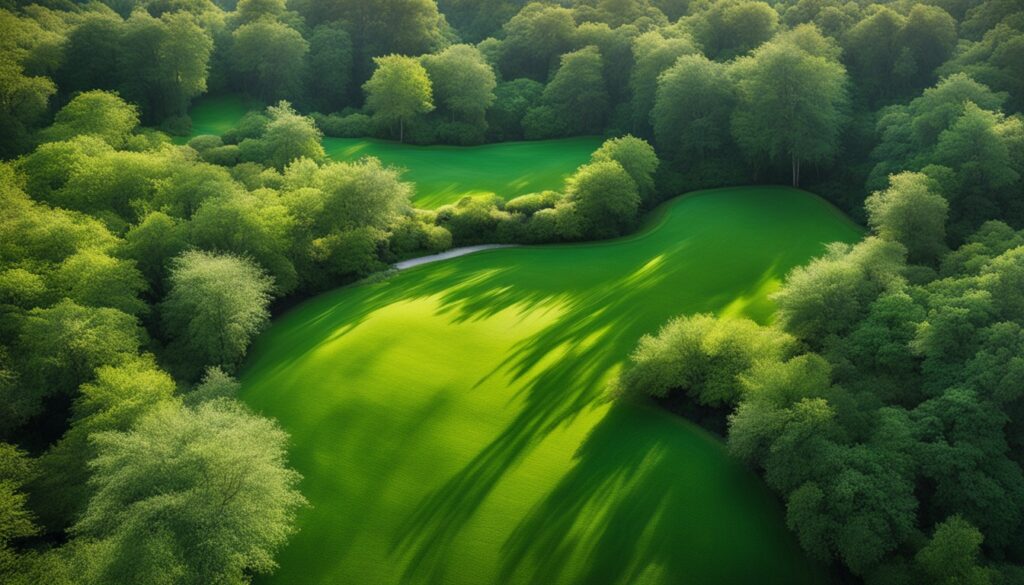I love working with dwarf hairgrass in my aquarium. It turns the bottom of the tank into a beautiful green carpet. This plant not only looks good but also helps keep my fish healthy. Caring for it has taught me to be patient and look at the small details.
There are different types of dwarf hairgrass. Eleocharis parvula is known for doing well in many settings. It grows into a thick green carpet if you trim it regularly. On the other hand, Eleocharis acicularis ‘mini’ and Eleocharis belem need more care. They do best with special soil, proper lighting, and CO2. They look like a tiny, magical meadow.
Looking after aquatic plants means checking the water often. The pH should be between 6.5 and 7.5. The temperature needs to be between 72 and 79 degrees. Plants need the right light to grow. Even tanks without CO2 can have great-looking dwarf hairgrass with the right conditions. Getting a full green carpet takes time, but it’s worth it.
Dwarf Hairgrass: An Aquatic Plant Overview

Dwarf Hairgrass has lush green blades that look amazing. It creates a dense carpet on the floor of an aquarium. This is not just for looks but also helps the aquatic ecosystems. It’s great for making oxygen and giving fry and invertebrates places to hide.
The Aesthetic Appeal of This Carpeting Plant
Aquarists love Dwarf Hairgrass because it makes the bottom of the tank green and beautiful. It grows closely together and stays at the same height. This makes your aquarium look more deep and complex.
Differentiating Between Dwarf Hairgrass and Other Varieties
There are many types of Dwarf Hairgrass. But, the Eleocharis parvula, or Mini Dwarf Hairgrass, is very popular. It’s shorter and grows denser. It’s important to know what your type needs, from light to water conditions.
Understanding the Aquatic Ecosystem Benefits of Hairgrass
Dwarf Hairgrass does more than look good. It creates a home for lots of different small creatures, adding to biodiversity. It also grows quickly and spreads, which helps keep the substrate in place. This stops erosion and keeps the water clear.
Characteristic |
Requirement or Benefit |
|---|---|
Aesthetic Appeal |
Creates lush green carpet-like effect, enhancing beauty |
Ecological Role |
Stabilizes substrate, supports microfauna, oxygenates water |
Growth Fast Facts |
Propagates via runners, low to moderate light needed |
Optimal Conditions |
pH 6.0-7.5, Temperature 68-82°F (20-28°C), CO2 supplementation beneficial |
To make Dwarf Hairgrass thrive, pick the right substrate and keep the light and pH levels ideal. It’s not only about making your tank look good. This plant also does a lot for the ecosystem in your aquarium.
Dwarf Hairgrass Planting Techniques

Learn to plant dwarf hairgrass, and you can make your aquascape look like a lush, green meadow. The right planting techniques help your plants grow fast and strong. They also make your water garden look beautiful. Let’s talk about how to do this step by step.
Start by preparing the dwarf hairgrass. Cut it into small pieces, with about 5-6 blades each. These small sizes help the grass root and spread quickly. Follow this easy guide for planting:
- The substrate should be fine, rich in nutrients, and hold the plants well.
- Plant the hairgrass bits with aquascaping tweezers. Place them 1-2 inches apart. This spacing helps them grow into a thick carpet.
- Keep the light on for at least 8 hours every day. Dwarf hairgrass needs medium to high light to grow well.
- Adding CO2 can boost growth and color. Aim for 20-30 ppm, though it’s optional.
If you’re looking for the best conditions for your dwarf hairgrass, here’s what I’ve learned:
Condition |
Ideal Range |
Notes |
|---|---|---|
Lighting |
3-5 watts per gallon |
Crucial for fast carpeting effect |
pH Level |
6.0-7.5 |
Slightly acidic to neutral is best |
Temperature |
68-82°F (20-28°C) |
Keeps growth steady |
CO2 Supplementation |
20-30 ppm |
Boosts growth and color, but optional |
Water Hardness |
4-12 dGH |
Keep it moderately hard |
Growing dwarf hairgrass needs patience. It can take weeks or months to fully cover the ground. Conditions like light and nutrients play a big part. Regular cuts help the grass grow thick and keep your tank looking neat.
Maintaining Your Dwarf Hairgrass: Trimming and CO2 Injection

If you love your aquarium, you know how important it is to take care of it. Keeping your dwarf hairgrass in good shape is about more than just looks. It affects the health of your whole tank. Let’s talk about methods like CO2 injections and trimming to keep your dwarf hairgrass happy.
Critical Role of CO2 in Dwarf Hairgrass Care and Growth
CO2 injections are key to keeping dwarf hairgrass healthy. Keeping CO2 levels at around 30ppm boosts growth. This makes the grass look like a lush carpet. Plus, it helps the grass stay a vibrant green, making it a favorite for aquarium fans.
Keeping your aquarium in check is super important. You might need to adjust the CO2 based on how fast the plants grow. Without extra CO2, these plants grow slower and might not look as good.
Trimming: When and How to Do It Correctly
Trimming your aquatic plants keeps your tank tidy and your dwarf hairgrass healthy. Trimming stops decay from hurting your water quality. Always use sharp scissors for clean cuts so the plants can heal and grow back strong.
Trimming encourages your plants to grow thicker. It makes sure light hits even the bottom parts, keeping your aquatic garden lush.
Signs That Your Aquatic Plant Needs Attention
Watching your dwarf hairgrass can show you how healthy your aquarium is. Things like slow growth or yellow spots mean something’s off. It could be CO2 levels, lighting, or not enough nutrients. Changing your care routine can help fix these problems.
The aim is to have a stunning underwater scene that’s also good for its inhabitants.
Dwarf Hairgrass Growth Rate: Patience for Lush Carpets

When I started growing dwarf hairgrass in my aquarium, I needed to learn about its growth rate. It’s essential for creating lush carpets. This plant requires patience and the right conditions to spread well.
To speed up its growth, proper light and substrate are key. A light intensity of 3-4 watts per gallon works best. With this setup, your tank can become fully carpeted in just a month, assuming other conditions are met.
- Growing dwarf hairgrass is more successful in sand substrate, but avoiding compaction is crucial. It helps the plant spread new runners.
- Higher initial plant density can help lower algae growth. This keeps your carpet looking good and healthy.
For dwarf hairgrass propagation, keeping CO2 levels stable is beneficial if possible. But, the plant can still form a carpet in rich soil without extra CO2. This has been my experience as well.
Keeping the carpet lush involves careful maintenance, like not trimming too soon. Dwarf hairgrass grows about 6 inches tall. This makes it great for hiding and feeding fry, adding to your tank’s ecosystem.
Trying the dry start method (DSM) could improve your success. The DSM has proven effective, but it needs careful light and setup management. Begin with 10 hours of light daily, then adjust as your plants grow.
Patience is indeed crucial for growing dwarf hairgrass. Regular care, the right planting approach, and managing your environment are all necessary. These steps help keep your carpet vibrant and healthy for a long time.
Cultivating Dwarf Hairgrass Roots for a Robust Plant
As an aquascaping enthusiast, I’ve learned a lot about dwarf hairgrass. The secret to a lush tank lies in its roots, hidden beneath the substrate. To get that healthy, robust look, it’s crucial to focus on the roots. A top choice among hobbyists is Flourite Black Sand. This substrate is rich in nutrients needed for strong roots. Adding root tabs to this creates the perfect environment for root growth.
Lighting is also key in this process. A setup with 2×15 Watt Spiral CFL lamps over a 10-gallon tank works well. It should light the tank for about 12.5 hours daily. This helps roots spread effectively. However, some still find it hard to get that dense carpet effect. Success lies in the details: mist spraying, checking water nutrient levels, and using a liquid CO2 supplement.
Patience plays a big role with dwarf hairgrass. It won’t turn into a lush lawn overnight. By separating the grass into small plantlets and trying different planting methods, you see progress. Grass laid horizontally can help roots and shoots grow better. This journey might be personal, but many share an interest. Stats show 27,000 views and 12 replies, with active members like Brian_T engaging. Success comes from adapting techniques to your tank’s specific needs. Trimming and adjusting lights gradually can make a big difference.








